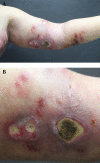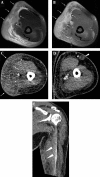Clinico-radiologic findings in primary cutaneous extranodal natural killer/t-cell lymphoma, nasal type mimicking cellulitis of the left arm
- PMID: 25793085
- PMCID: PMC4349107
- DOI: 10.5812/iranjradiol.12597
Clinico-radiologic findings in primary cutaneous extranodal natural killer/t-cell lymphoma, nasal type mimicking cellulitis of the left arm
Abstract
Extranodal natural killer (NK)/T-cell lymphoma is a very rare and aggressive disease characterized histopathologically by an Epstein-Barr virus (EBV)-positive atypical lymphoid cytotoxic infiltrate, extensive vascular destruction, and prominent tissue necrosis. It commonly shows cutaneous lesions that primarily or secondarily mimic cellulitis at the primary site. We report on a very rare case of extranodal NK/T-cell lymphoma, nasal type of skin/soft tissue, in a 64-year-old man, and describe the radiological findings. The condition was misdiagnosed as cellulitis of the left arm based on initial noninvasive clinical and radiologic work-up.
Keywords: Cellulitis; Lymphoma; Natural Killer T-Cell.
Figures




Similar articles
-
Cutaneous extranodal natural killer/T-cell lymphoma mimicking cellulitis: A unique presentation.JAAD Case Rep. 2020 Oct 10;6(12):1275-1277. doi: 10.1016/j.jdcr.2020.09.028. eCollection 2020 Dec. JAAD Case Rep. 2020. PMID: 33294562 Free PMC article. No abstract available.
-
Cutaneous peripheral T-cell lymphoma of cytotoxic phenotype mimicking extranodal NK/T-cell lymphoma.Am J Dermatopathol. 2011 Apr;33(2):e17-20. doi: 10.1097/DAD.0b013e3181ea6571. Am J Dermatopathol. 2011. PMID: 21252637
-
Primary cutaneous extranodal natural killer/T-cell lymphoma presenting as bilateral erythematous patches on the arms.Indian J Dermatol Venereol Leprol. 2017 Jul-Aug;83(4):453-456. doi: 10.4103/ijdvl.IJDVL_264_16. Indian J Dermatol Venereol Leprol. 2017. PMID: 28474639
-
[Extranodal T/NK-cell lymphoma, nasal type: a case report and review of the literature].An Med Interna. 2005 Dec;22(12):597-600. doi: 10.4321/s0212-71992005001200010. An Med Interna. 2005. PMID: 16454602 Review. Spanish.
-
Extranodal nasal-type natural killer/T-cell lymphoma with penile involvement: a case report and review of the literature.BMC Urol. 2017 Sep 6;17(1):77. doi: 10.1186/s12894-017-0273-8. BMC Urol. 2017. PMID: 28874193 Free PMC article. Review.
Cited by
-
Uveitis and Myositis as Immune Complications in Chemorefractory NK/T-Cell Nasal-Type Lymphoma Successfully Treated with Allogeneic Stem-Cell Transplant.Case Rep Hematol. 2016;2016:7297920. doi: 10.1155/2016/7297920. Epub 2016 Oct 11. Case Rep Hematol. 2016. PMID: 27807488 Free PMC article.
-
Extranodal NK/T Cell Lymphoma, Nasal Type (ENKTL-NT): An Update on Epidemiology, Clinical Presentation, and Natural History in North American and European Cases.Curr Hematol Malig Rep. 2016 Dec;11(6):514-527. doi: 10.1007/s11899-016-0355-9. Curr Hematol Malig Rep. 2016. PMID: 27778143 Free PMC article. Review.
-
Cutaneous extranodal natural killer/T-cell lymphoma mimicking cellulitis: A unique presentation.JAAD Case Rep. 2020 Oct 10;6(12):1275-1277. doi: 10.1016/j.jdcr.2020.09.028. eCollection 2020 Dec. JAAD Case Rep. 2020. PMID: 33294562 Free PMC article. No abstract available.
References
-
- Tomonaga M. [Outline and direction of revised WHO classification of Tumors of Haematopoietic and Lymphoid Tissues]. Rinsho Ketsueki. 2009;50(10):1401–6. - PubMed
Publication types
LinkOut - more resources
Full Text Sources
Other Literature Sources
